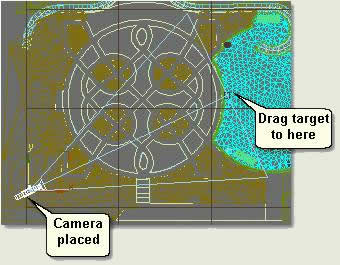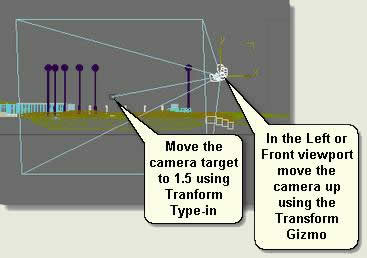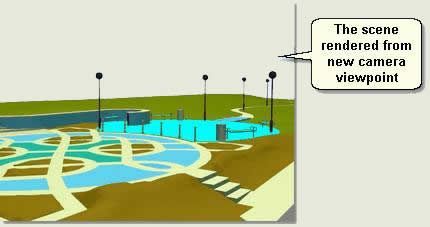How To Move The Camera In 3d Max
Cameras
Introduction
Cameras are the chief viewing tools in 3D visualisation. They are placed in the scene either manually or from the Perspective viewport and named uniquely. Multiple cameras tin exist in the scene, each 1 with carve up views to show the client around the scene. They are also used extensively to assist modelling and to keep a tight hold on what needs modelling and at what detail. Cameras tin await at a target or be gratuitous to follow a path in animation, and the user can change a number of parameters like to a existent camera. This tutorial explores the basic process of working with cameras.
Two types of camera are available: Target for keeping the camera view stock-still on a point wherever the photographic camera is placed and Free for manipulating freely and for use on path animations such equally walkthrough movies
This tutorial explains the creation and manipulation of a Target camera. The use of a Gratis camera is explained in the 'Blitheness' tutorial when animating a photographic camera forth a path. The basic parameters for both types, however, are explained here
Download Sample Data
In lodge to follow this tutorial, you may want to use the supplied files. Please read the sample information instructions earlier downloading.
kf401_files.zippo (387kb)
Top of page
Method 1
from the Create Panel
- Open kf401_01.max This scene contains the completed tutorial mural model (without materials) plus a couple of lights (hidden) to add brightness for this exercise (lighting is covered later)
- Create Panel > Cameras > Target. The Target button turns orange showing the command is agile. The cursor changes to a big cross
- In the Top viewport left click where you desire the camera to exist placed then elevate (keeping the left finger on the mouse push) to where you want the target to be (ie where the photographic camera volition expect). Take the left finger off the mouse button to finish the creation process
- Right click to terminate the command - the Target button turns back to grey
Annotation: In practice just place the camera roughly and then change the position of camera and target afterwards in the Top and Left viewports thus:

- Select Camera 01
- In the Left viewport move the camera upwards using the Transform Gizmo
- Select Camera 01.Target and use Movement Transform Type-in dialog to motility the target to 1.5
TIP: If the camera is to be placed at head height so the target needs to be roughly head height and perhaps down from the camera Z position slightly. The camera tin be moved upwardly or down over the site in the knowledge that if placed back at head height the target volition be already correctly placed on the Z centrality

- Correct click in the Front viewport to make it active and type C. This changes the viewport to a Photographic camera viewport
- Change the viewport display to Shine + Highlights
- In the Superlative viewport motion the camera effectually and view the camera view in the Photographic camera viewport

- Practice moving the camera and target independently in the Elevation viewport to gain many views and irresolute the height of the camera in the Left viewport
Superlative of page
Method 2
from the Perspective viewport
- Brand the User viewport agile and type P this changes the viewport to a Perspective viewport
- Move around the scene in the Perspective viewport (selecting a central object and Arc Rotating for efficiency) until the desired view is accomplished
- Utilize the Zoom and Field of View navigation tools
- Views > Create Camera from View. This creates a new photographic camera chosen Camera 02. This is a Free Photographic camera which does not have a target
- Right click in the Camera 01 viewport and blazon F and make the display wireframe. This makes the viewport Front end viewport and making the display wireframe keeps the display efficient
- Make the Photographic camera viewport agile
- Correct click viewport carte du jour > Views. Select Camera 01 to change the view to Camera 01
- Rename the cameras to 'view' names such as 'Towards steps from building' so that yous tin recognise the cameras in future
TIP: Instead of creating new cameras every time, peradventure clone them and rename. Then much of the positioning of the camera and target (especially on the Z centrality) is already washed. Go on i viewport every bit Photographic camera viewport and change the views when needed. Use cameras to go on a tight hold on what you really demand to model and in what detail. Utilize cameras sooner rather than subsequently for efficient viewing and modelling
Top of page
Photographic camera Parameters
- Select the free camera created from the Perspective viewport
- Modify Panel > Parameters > FOV. Move the Field of View up and down and notice the effect in the viewports
- Apply the Stock Lenses buttons to change the field of view rapidly
NOTE: The Field of View besides changes the Lens value. This relates the field of view to standard camera settings. A standard person'due south field of view is equivalent to a 35mm lens
- Under Blazon change the camera to a Target photographic camera. This puts a target on the camera
- Motion the camera around in the Top viewport to see the view moving around the Target
Note: Many more advanced settings exist for cameras such as clipping planes and Multi-Pass furnishings for scene depth and atmosphere. These are not covered past Primal Fundamentals
Tiptop of page
Donate to CADTutor
If yous found this tutorial useful, y'all might like to consider making a donation. All content on this site is provided gratis of charge and nosotros hope to continue information technology that way. All the same, running a site like CADTutor does price coin and you can aid to improve the service and to guarantee its futurity by altruistic a pocket-size amount. Nosotros guess that y'all probably wouldn't miss $v.00 but information technology would make all the departure to u.s..
Source: https://www.cadtutor.net/tutorials/3ds-max/cameras.php
Posted by: raulstonsommom90.blogspot.com

0 Response to "How To Move The Camera In 3d Max"
Post a Comment